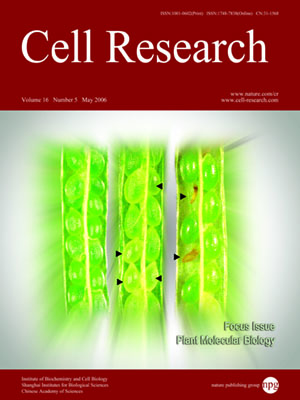
Volume 16, No 5, May 2006
ISSN: 1001-0602
EISSN: 1748-7838 2018
impact factor 17.848*
(Clarivate Analytics, 2019)
Volume 16 Issue 5, May 2006: 499-506
ORIGINAL ARTICLES
Wrinkled petals and stamens 1, is required for the morphogenesis of petals and stamens in Lotus japonicus
Jiang Hua Chen, Ji Liang Pang, Li Lin Wang, Yong Hai Luo, Xin Li, Xiang Ling Cao, Kui Lin, Wei Ma, Xiao He Hu, Da Luo
1National Laboratory of Plant Molecular Genetics, Institute of Plant Physiology and Ecology, Shanghai Institutes for Biological Sciences, and Graduate School of the Chinese Academy of Sciences, Chinese Academy of Sciences, 300 Fenglin Road, Shanghai 200032, China; 2School of Life Science, Hangzhou Normal College, 16 Xuelin Road, Hangzhou 310018, China; 3School of Life Science and Biotechnology, Shanghai Jiao Tong University, 1954 Huashan Road, Shanghai 200030, China
Correspondence: Da Luo(dluo@sibs.ac.cn)
Although much progress has been made in understanding how floral organ identity is determined during the floral development, less is known about how floral organ is elaborated in the late floral developmental stages. Here we describe a novel floral mutant, wrinkled petals and stamens1 (wps1), which shows defects in the development of petals and stamens. Genetic analysis indicates that wps1 mutant is corresponding to a single recessive locus at the long arm of chromosome 3. The early development of floral organs in wps1 mutant is similar to that in wild type, and the malfunction of the mutant commences in late developmental stages, displaying a defect on the appearance of petals and stamens. In the mature flower, petals and stamen filaments in the mutant are wrinkled or folded, and the cellular morphology under L1 layer of petals and stamen filaments is abnormal. It is found that the expression patterns of floral organ identity genes are not affected in wps1 mutants compared with that of wild type, consistent with the unaltered development of all floral organs. Furthermore, the identities of epidermal cells in different type of petals are maintained. The histological analysis shows that in wps1 flowers all petals are irregularly folded, and there are knotted structures in the petals, while the shape and arrangement of inner cells are malformed and unorganized. Based on these results, we propose that Wps1 acts downstream to the class B floral organ identity genes, and functions to modulate the cellular differentiation during the late flower developmental stages.
Cell Research (2006) 16:499-506. doi:10.1038/sj.cr.7310061; published online 15 May 2006
FULL TEXT | PDF
Browse 1959


